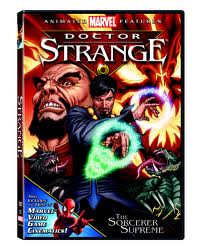Doctor Strange
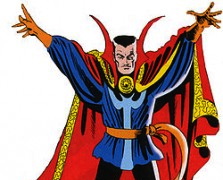
Spider-Man S-3 E-1 “Doctor Strange”
Spider-Man The Animated Series: Season 3 Episode 1 “Doctor Strange.”
Doctor Stephen Vincent Strange is a fictional superhero who appears in comic books published by Marvel Comics. Doctor Strange is a former neurosurgeon, a practicing sorcerer, and serves as the Sorcerer Supreme, the primary protector of Earth against magical and mystical threats. Debuting in the Silver Age of comics, the character has featured in several self-titled series and Marvel-endorsed products including arcade and video games; animated television series; a direct-to-DVD film; and merchandise such as trading cards.
1960’s
Co-created by writer-editor Stan Lee and artist/co-plotter Steve Ditko, the character debuted in Strange Tales #110 (July 1963), a “split book” shared with fellow Marvel character the Human Torch until issue #134 (July 1965), and then super-spyNick Fury until issue #168 (May 1968). Doctor Strange appeared in issues #110-111 and #114 before the character’s eight-pageorigin story appeared in #115 (Dec. 1963). The character was inspired by the Chandu the Magician radio program which aired on theMutual Broadcasting System in the 1930’s.
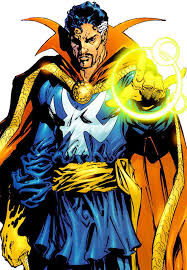 Ditko drew the feature through Strange Tales #146 (July 1966), and during this period he and Lee introduced many of Strange’s allies, such as his eventual lover Clea, who debuted (although not initially named) in Strange Tales #126 (Nov. 1964); and enemies, such as Nightmare in #110, and the flame-headed Dormammu, in #126 (Nov. 1964). Doctor Strange stories showcased surrealistic mystical landscapes and increasingly head-trippy visuals that helped make the feature a favorite of college students. Comics historian Mike Benton wrote,
Ditko drew the feature through Strange Tales #146 (July 1966), and during this period he and Lee introduced many of Strange’s allies, such as his eventual lover Clea, who debuted (although not initially named) in Strange Tales #126 (Nov. 1964); and enemies, such as Nightmare in #110, and the flame-headed Dormammu, in #126 (Nov. 1964). Doctor Strange stories showcased surrealistic mystical landscapes and increasingly head-trippy visuals that helped make the feature a favorite of college students. Comics historian Mike Benton wrote,
“The Dr. Strange stories of the 1960’s constructed a cohesive cosmology that would have thrilled any self-respecting theosophist. College students, minds freshly opened by psychedelic experiences and Eastern mysticism, read Ditko and Lee’s Dr. Strange stories with the belief of a recent Hare Krishna convert. Meaning was everywhere, and readers analyzed the Dr. Strange stories for their relationship to Egyptian myths, Sumarian gods, and Jungian archetypes.”
“People who read ‘Doctor Strange’ thought people at Marvel must be heads [i.e., drug users],” recalled then-associate editor and former Doctor Strange writer Roy Thomas in 1971, “because they had had similar experiences high on mushrooms. But … I don’t use hallucinogens, nor do I think any artists do.”
As co-plotter and later sole plotter, (in the “Marvel Method“), Ditko would take Strange into ever-more-abstract realms. In an epic 17-issue story arc in Strange Tales #130-146 (July 1965 – July 1966), Ditko introduced the cosmic character Eternity, who personified the universe and was depicted as a silhouette whose outlines are filled with the cosmos. As historian Bradford W. Wright describes,
Steve Ditko contributed some of his most surrealistic work to the comic book and gave it a disorienting, hallucinogenic quality. Dr. Strange’s adventures take place in bizarre worlds and twisting dimensions that resembled Salvador Dalí paintings. …Inspired by the pulp-fiction magicians of Stan Lee’s childhood as well as by contemporary Beat culture. Dr. Strange remarkably predicted the youth counterculture’s fascination with Eastern mysticism and psychedelia. Never among Marvel’s more popular or accessible characters, Dr. Strange still found a niche among an audience seeking a challenging alternative to more conventional superhero fare.
From the beginning, Doctor Strange used magical artifacts to augment his power, such as the Cloak of Levitation, the Eye of Agamotto, the Book of the Vishanti, and the Orb of Agamotto. From the first story, Strange’s residence, the Sanctum Sanctorum, was a part of the character’s mythos. Strange’s personal servant, Wong, introduced in #110 (July 1963), guarded the residence in his absence.
 Splash page for the “Doctor Strange” story in Strange Tales #110 (July 1963). Art by Steve Ditko.
Splash page for the “Doctor Strange” story in Strange Tales #110 (July 1963). Art by Steve Ditko.
In keeping with Lee’s emphasis on continuity, Strange guest starred in The Fantastic Four #27 (June 1964) and The Amazing Spider-Man Annual #2 (1965), and encountered the Norse god Loki, foster brother of Thor, in Strange Tales #123 (August 1964).
The series continued with Lee dialoging Ditko’s plots through Strange Tales #142, followed by Roy Thomas and Denny O’Neil (two issues each). Golden Age artist/writerBill Everett succeeded Ditko as artist with issues #147-152, followed by Marie Severinthrough #160 and Dan Adkins through #168, the final issue before the Nick Fury feature moved to its own title and Strange Tales was renamed Doctor Strange.
Lee returned to write the character in Strange Tales #151-157; followed by Thomas (#158-159); and two writers who did virtually no other Marvel work, Raymond Marais (#160-161) and Jim Lawrence (#162-166). Another cosmic entity, the Living Tribunal, was introduced in issue #157 (June 1967) and the evil Umar, sister of Dormammu, in #150 (Nov. 1966).
Expanded to 20 pages per issue, the Doctor Strange solo series ran 15 issues, #169-183 (June 1968 – Nov. 1969), continuing the numbering of Strange Tales. Thomas wrote the run of new stories, joined after the first three issues by the art team of penciler Gene Colan and inker Tom Palmer through the end. Colan drastically altered the look of the series, as Thomas recounted: “…he had his own view of what these other worlds should look like. Everyone else sort of copied Ditko’s versions of those extra dimensions, which were great and wonderful. When Gene came on, he didn’t feel an real rapport with that, I guess, so his extra dimensions tended to be just blackness and smoke and things of that sort… Sometimes it was a little strange for a dimension Doc Strange had been to before to look different when drawn by Gene, but nobody complained.” In #177, Thomas and Colan attempted to boost sales by revamping Strange’s appearance to more closely resemble those of other superheroes, giving him a form-fitting blue costume, a full-head mask and a secret identity as Dr. Stephen Sanders. The cancellation with #183 was abrupt (there was a “Next issue” blurb in the last issue), and outstanding storylines were resolved in Sub-Mariner #22 (Feb. 1970) and The Incredible Hulk vol. 2, #126 (April 1970).
Thomas recalled in 2000 that he eloped in July 1968 to marry his first wife, Jean, and returned to work a day late from a weekend comic book convention to find that Marvel production manager Sol Brodsky had assigned Doctor Strange to writer Archie Goodwin, newly ensconced at Marvel and writing Iron Man. Thomas convinced Brodsky to allow him to continue writing the title. “I got very possessive about Doctor Strange,” Thomas recalled. “It wasn’t a huge seller, but [by the time it was canceled] we were selling the low 40 percent range of more than 400,000 print run, so it was actually selling a couple hundred thousand copies [but] at the time you needed to sell even more.”
1970’s – 1990’s
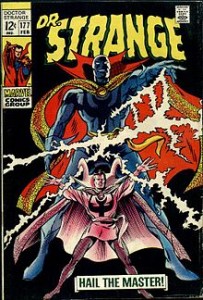 Doctor Strange #177 (Feb. 1969), the debut of Strange’s short-lived new look. Cover art by Gene Colan and Tom Palmer.
Doctor Strange #177 (Feb. 1969), the debut of Strange’s short-lived new look. Cover art by Gene Colan and Tom Palmer.
After plans were announced for a never-realized “split book” series featuring Doctor Strange and Iceman each in solo adventures, Strange next appeared in the first three issues (Dec. 1971 – June 1972) of the quarterly showcase title Marvel Feature, appearing in both the main story detailing the formation of superhero “non-team” the Defenders, and the related back-up story. The character then starred in a revival solo series in Marvel Premiere #3-14 (July 1972 – March 1974). This arc marked the debut of another recurring foe, the entity Shuma-Gorath, created by writer Steve Englehart and artist Frank Brunner. In issues #8-10 (May-Sept. 1973), in order to stop Shuma-Gorath from entering our reality, Strange was forced to shut down the Ancient One’s mind, causing his mentor’s physical death. Strange then assumed the title of Sorcerer Supreme. Englehart and Brunner created a multi-issue storyline in which a sorcerer named Sise-Neg (“Genesis” spelled backward) goes back through history, collecting all magical energies, until he reaches the beginning of the universe, becomes all-powerful and creates it anew, leaving Strange to wonder whether this was, paradoxically, the original creation. Stan Lee, seeing the issue after publication, ordered Englehart and Brunner to print a retraction saying this was not God but a god, so as to avoid offending religious readers. The writer and artist concocted a fake letter from a fictitious minister praising the story, and mailed it to Marvel from Texas; Marvel unwittingly printed the letter, and dropped the retraction order.
The Marvel Premiere series segued to the character’s second ongoing title, Doctor Strange: Master of the Mystic Arts, also known as Doctor Strange vol. 2, which ran 81 issues (June 1974 – Feb. 1987). Doctor Strange #14 featured a crossover story with The Tomb of Dracula #44, another series which was being drawn by Gene Colan at the time. In Englehart’s final story for the series, he sent Dr. Strange back in time to meet Benjamin Franklin.
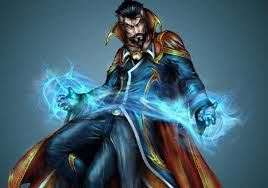 Strange met his allies Topaz in #75 (Feb. 1986) and Rintrah in #80 (Dec. 1986). The series ended with a cliffhanger as the Sanctum Sanctorum was heavily damaged during a battle. Among the losses was Doctor Strange’s entire collection of mystic books and other important artifacts. As a consequence, Strange was now considerably weaker and several spells designed to protect humanity from vampires and the evil serpent god Set would now expire.
Strange met his allies Topaz in #75 (Feb. 1986) and Rintrah in #80 (Dec. 1986). The series ended with a cliffhanger as the Sanctum Sanctorum was heavily damaged during a battle. Among the losses was Doctor Strange’s entire collection of mystic books and other important artifacts. As a consequence, Strange was now considerably weaker and several spells designed to protect humanity from vampires and the evil serpent god Set would now expire.
The title was discontinued so that the character’s adventures could be transferred to another “split book” format series, Strange Tales vol. 2, #1-19 (April 1987 – Oct. 1988), which was shared with street heroes Cloak and Dagger. This new Doctor Strange series resolved Strange’s quest to reclaim his power and missing artifacts, as well as resurrect the Defenders, who had died in the last issue of that team’s title.
Strange was returned to his own series, this time titled Doctor Strange: Sorcerer Supreme, which ran 90 issues (Nov. 1988 – June 1996). The initial creative team was writer Peter B. Gillis and artists Richard Case and Randy Emberlin, with storylines often written as multi-issue arcs. Strange lost the title of “Sorcerer Supreme” in issues #48-49 (Dec. 1992 – Jan. 1993) when he refused to fight a war on behalf of the Vishanti, the mystical entities that empower his spells. During this time the series became part of the “Midnight Sons” group of Marvel’s supernatural comics, and Doctor Strange found new sources of magical strength in the form of chaos magic as well as a magic construct he used as a proxy. He would form the Secret Defenders with a rotating roster of heroes, and reunite with the original Defenders. Strange regained his title in Doctor Strange: Sorcerer Supreme #80 (Aug. 1995).
Strange appeared – together with original regulars the Human Torch and the Thing – in the one-shot publication Strange Tales vol. 3, #1 (Nov. 1994).
The character was featured in several limited series, the first being Doctor Strange: The Flight of Bones #1-4 (Feb.–May 1999), with a series of spontaneous combustions by criminals instigated by old foe Dormammu. Strange was the catalyst for the creation of a trio of sorceresses in Witches #1-4 (Aug.–Nov. 2004). The Strange limited series (Nov. 2004-July 2005) by writers J. Michael Straczynski and Samm Barnes updated the character’s origin. Another limited series, Doctor Strange: The Oath #1-5 (Dec. 2006 – April 2007), written by Brian K Vaughan and illustrated by Marcos Martin, focused on Strange’s responsibilities as both sorcerer and doctor.
Doctor Strange has appeared in four graphic novels over the years: Doctor Strange: Into Shamballa (1986); Doctor Strange & Doctor Doom: Triumph and Torment (1989); Spider-Man/Dr. Strange: The Way to Dusty Death (1992); and Dr. Strange: What is it that Disturbs You, Stephen? (Oct. 1997).
Strange appeared as a supporting character in the 2000s. In New Avengers #7 (July 2005), writer Brian Michael Bendis retconned Marvel history and established that in the past, several metahumans, including Strange, formed a secret council called the Illuminati to deal with future threats to Earth. In present-day continuity, during the 2006-2007 company-wide Civil War storyline involving the introduction of a federal Superhuman Registration Act, which splits the superhero community, Strange is opposed to mandatory registration and later secretly shelters in his residence the anti-registration splinter group of the Avengers. Strange then sought out a successor Sorcerer Supreme and after he had considered several magicians such as Wiccan, the Scarlet Witch, Magik, and Doctor Doom, the Eye of Agamotto chose Brother Voodoo.


